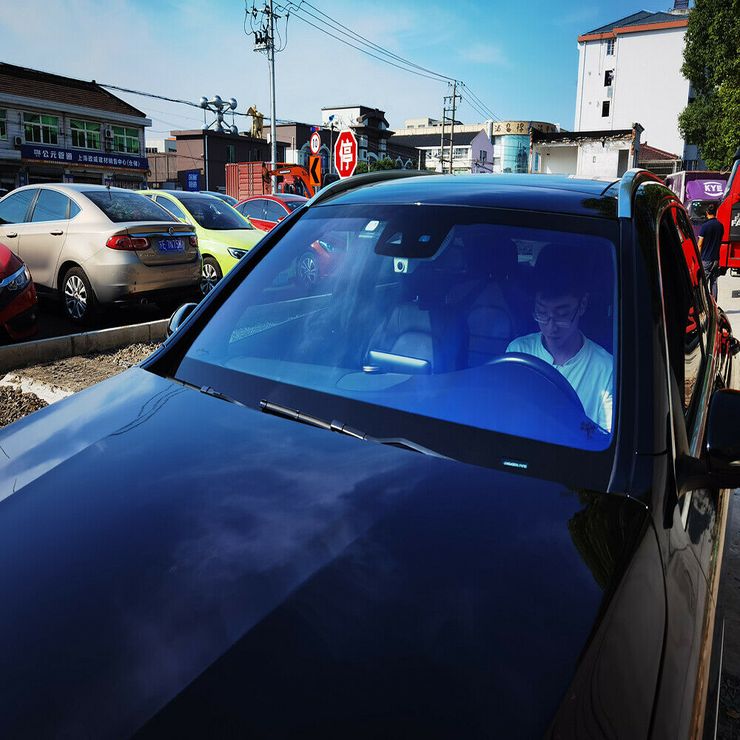Why the traffic police do not stop cars for blue “tinted” windows
- December 21, 2022
- 0
Every motorist met cars on the road, in which not only side windows, but also windshields have a kind of blue coating – sometimes with a purple or
Every motorist met cars on the road, in which not only side windows, but also windshields have a kind of blue coating – sometimes with a purple or

The point here is not at all that such a “blue” is usually flaunted by premium brand cars, and the police do not want to mess with their troublesome owners again. This actually happens because “blue tinting” is not inherently tinted. In a similar way, the main difference between the so-called athermal glasses and ordinary glasses is manifested externally. The former are able to partially retard, partially reflect, thermal (infrared) and ultraviolet radiation, preventing them from penetrating the interior of the vehicle. Thus, the energy of IR and UV rays is not involved in the heating of seats, upholstery and other interior elements.
We see the sun’s ultraviolet reflected off the athermal glass and observe the car’s powerful blue-violet “hue” when it is in the sun. The more intense the sun shines, the more UV is reflected and the less visible the interior of the car is to an outsider. This effect is not achieved by covering the glass with films. Although all color companies also offer everyone a coating for glasses of this color. In our case, we are talking about special additives in the composition of athermal glass. Even at the production stage, compounds containing iron and silver molecules are added.
It is they who are responsible for the absorption-reflection of unnecessary radiation, and xx ratio and concentration determine the color of the finished “athermal”. There are car glasses of this type, not only bluish, but also greenish. And through polarized glasses, they sometimes look like pure purple. Any normal traffic cop knows this. Why would he slow down a car with ordinary athermal glazing?
After all, before domestic official dealers start selling such a model of a passenger car, it undergoes state certification. In doing so, the legally required degree of light transmission for the “frontal” and the front side windows is confirmed – 75% and 70% respectively.
Although athermal glass was still a curiosity on the roads of Russia (about 10 years ago), traffic police officers sometimes tried to “dig” the owners of “blue tint” cars. Now there is no problem. Unless a “very smart” Krasnodar traffic cop sometimes tries to “divorce” from a blonde who drives an expensive foreign car with athermal glass for a bribe “for painting”.

The point here is not at all that such a “blue” is usually flaunted by premium brand cars, and the police do not want to mess with their troublesome owners again. This actually happens because “blue tinting” is not inherently tinted. In a similar way, the main difference between the so-called athermal glasses and ordinary glasses is manifested externally. The former are able to partially retard, partially reflect, thermal (infrared) and ultraviolet radiation, preventing them from penetrating the interior of the vehicle. Thus, the energy of IR and UV rays is not involved in the heating of seats, upholstery and other interior elements.
We see the sun’s ultraviolet reflected off the athermal glass and observe the car’s powerful blue-violet “hue” when it is in the sun. The more intense the sun shines, the more UV is reflected and the less visible the interior of the car is to an outsider. This effect is not achieved by covering the glass with films. Although all color companies also offer everyone a coating for glasses of this color. In our case, we are talking about special additives in the composition of athermal glass. Even at the production stage, compounds containing iron and silver molecules are added.
It is they who are responsible for the absorption-reflection of unnecessary radiation, and xx ratio and concentration determine the color of the finished “athermal”. There are car glasses of this type, not only bluish, but also greenish. And through polarized glasses, they sometimes look like pure purple. Any normal traffic cop knows this. Why would he slow down a car with ordinary athermal glazing?
After all, before domestic official dealers start selling such a model of a passenger car, it undergoes state certification. In doing so, the legally required degree of light transmission for the “frontal” and the front side windows is confirmed – 75% and 70% respectively.
Although athermal glass was still a curiosity on the roads of Russia (about 10 years ago), traffic police officers sometimes tried to “dig” the owners of “blue tint” cars. Now there is no problem. Unless a “very smart” Krasnodar traffic cop sometimes tries to “divorce” from a blonde who drives an expensive foreign car with athermal glass for a bribe “for painting”.
Source: Avto Vzglyad
Donald Salinas is an experienced automobile journalist and writer for Div Bracket. He brings his readers the latest news and developments from the world of automobiles, offering a unique and knowledgeable perspective on the latest trends and innovations in the automotive industry.